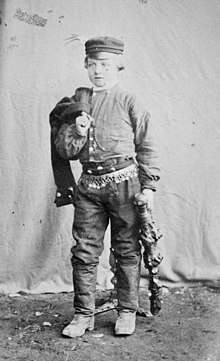Bidding stick
A bidding stick[1][2][3] (sometimes also referred to as a budstikke,[4][5][6][7] war arrow,[7] or stembod[8]) is a term for a wooden object, such as a club or baton, carried by a messenger and used by Northern Europeans, for example in Scotland and Scandinavia, to rally people for things (assemblies) and for defence or rebellion.
Scotland
In Scotland, such a token (Scottish Gaelic: crann-tara,[9][10] translated as "fiery cross"[11][12] or "cross of shame"[11]) was used to rally clan members to arms. The practice is described in the novels and poetry of Sir Walter Scott. A small burning cross or charred piece of wood would be carried from town to town. A widely known use was in the 1715 Jacobite rising, although it was used more recently among Scottish settlers in Canada during the War of 1812.[13] In 1820, over 800 fighting men of the Scottish Clan Grant were gathered, by the passing of the Fiery Cross, to come to the aid of their Clan Chief and his sister in the town of Elgin.[14]
The name Crann Tara was used for a Scottish Gaelic current affairs programme on Grampian Television (ITV).[15]
Scandinavia

When an enemy had arrived, bidding sticks (Old Swedish: buþkafle (sg.)) were sent in all directions. In Sweden, they consisted of clubs, or just wooden chunks; in Norway, there were repurposed arrows. Sometimes the bidding sticks had a string attached to one end and were charred on the other end; Olaus Magnus (1555) relates that those who did not bring the club to the next village would be hanged and their homesteads burnt down.
When the people were assembled to a thing, the object was in the shape of an axe, or if the meeting concerned blasphemy, it was a cross.
The objects were signed with runes or other marks in order to indicate the reason for the assembly (e.g. election of king at the Stone of Mora), and who had sent them. During the Middle Ages, using buþkaflar was the official method of assembling people, and they were only allowed to be carved by certain officials, e.g. governors and sheriffs.
They were especially efficient, however, when they were used to levy people against royal oppression and high taxes. After the Dalecarlian rebellion of 1743, strong checks were placed on the use of bidding sticks.
In Sweden, the bidding stick was standardized during the village reorganizations in 1742, and it was at the village level that they were frequently used. During the 19th and 20th centuries, more specific messages were attached to the clubs or inserted into a hollow space. Still in the early 20th century, there was a paragraph in Swedish law that stated that the bidding stick would be sent between the villages if there was a forest fire. — Similar paragraphs were also present in the Finnish legislation concerning the correct use of arpakapula, or budkavle in Finland’s Swedish, till the 20th century.[16]
Newspapers
The concept of the bidding stick has been used as the name for several newspapers, including the Norwegian papers Budstikka, Budstikken, and Bremanger Budstikke, and the Faroese paper Tingakrossur.
References
- Bell, William. 1862. On the So-Called Ring-Money ... Proceedings of the Royal Irish Academy 8(1): 253–268, p. 260.
- Yonge, Charlotte M. 1884. History of Christian Names. London: Macmillan and Co., p. 413.
- West, John Frederick. 1972. Faroe: The Emergence of a Nation. London: C. Hurst, p. 24.
- Marryat, Horace. 1860. A Residence in Jutland, the Danish Isles, and Copenhagen, volume 1. London: John Murray, p. 33.
- Williams, Henry Smith. 1908. Scandinavia, Switzerland to 1715. New York: The Outlook Company, p. 91.
- Klausen, Arne Martin. 1999. The Torch Relay: Reinvention of Tradition and Conflict with the Greeks. In Arne Martin Klausen (ed.), Olympic Games as Performance and Public Event: The Case of the XVII Winter Olympic Games in Norway, pp. 75–96. New York: Berghahn, p. 95.
- Simon, Jeffrey. 1988. NATO-Warsaw Pact Force Mobilization. Washington, DC: National Defense University Press, p. 520.
- Withrington, Donald J. 1983. Shetland and the outside world, 1469-1969. Oxford: Oxford University Press, p. 58.
- "Crann-tara". at Dwelly's Gaelic Dictionary.
- "crann-tara". ann Am Faclair Beag.
- The Royal School History of Scotland. 1873. London: T. Nelson and Sons, p. 247.
- Pittock, Murray. 1999. Celtic Identity and the British Image. Manchester: Manchester University Press, p. 5.
- Crann-tara – “The gathering beam, a signal formally used on occasion of insult or impending danger, to summon a clan to arms. It was a piece of wood, half burnt and dipped in blood, in token of the revenge by fire and sword awaiting those clansmen who did not immediately answer the summons. It was passed from one permanently appointed messenger to another, and in this manner the alarm was spread across the largest districts in an incredibly short time. In 1745 the crann-tara traversed the wide district of Breadalbane, upwards of 30 miles in three hours.” Dwelly, Edward (1973). The Illustrated Gaelic English Dictionary (8th ed.). Glasgow: Gairm Publications. page 264
- "Clan Grant History & Facts". Archived from the original on 2008-01-13.
- Gaelic and Welsh House of Commons Debate, Hansard, 20 July 1988 vol 137 cc641-2W
- Hakkila, Esko (ed.): ”Arpakapula.” Lakiasiain käsikirja, p. 40. Porvoo: Werner Söderström Oy, 1938. — The most prominent regulations were in the Criminal Code of 1889 (chapter 44, §§ 23–24).